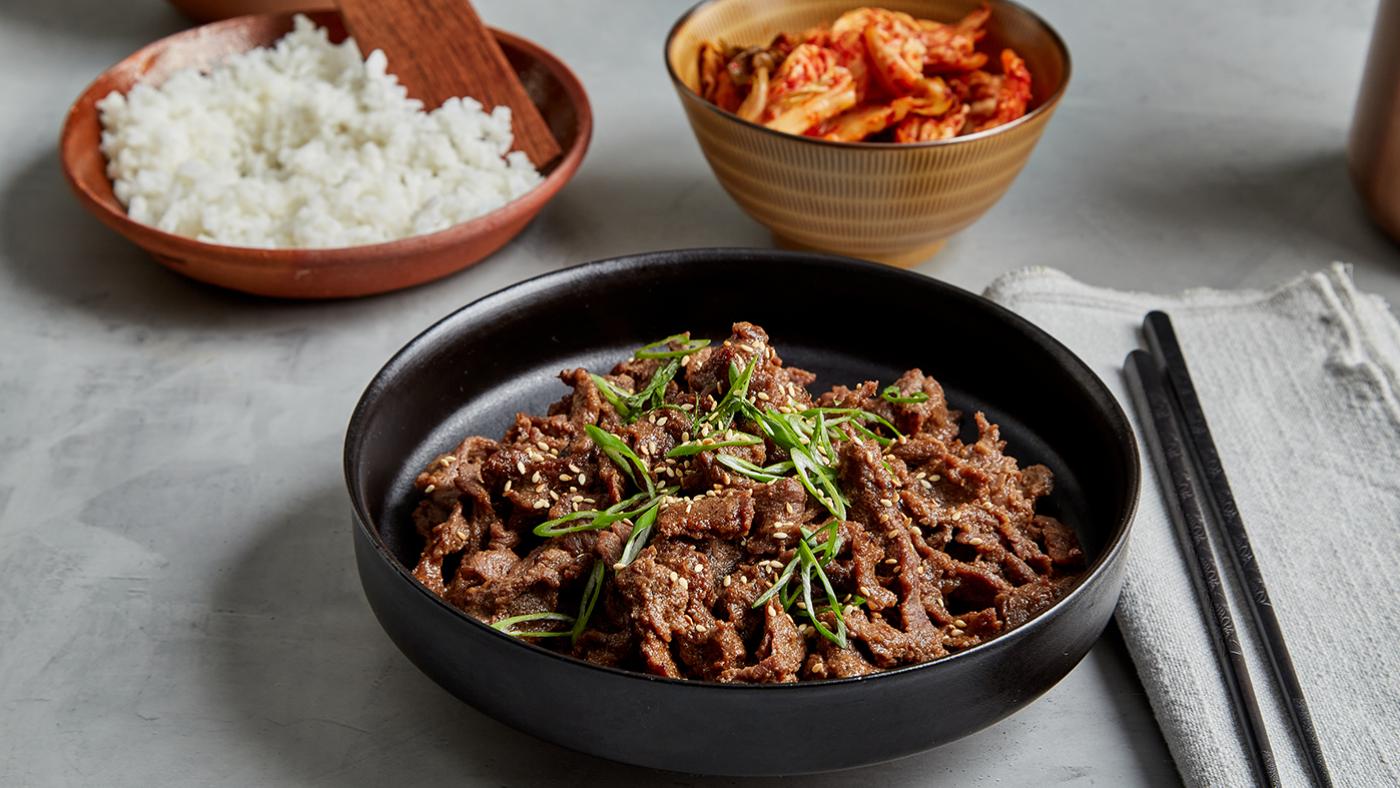A Beef Bulgogi Recipe from 'Christopher Kimball's Milk Street'
Daniel Hautzinger
September 5, 2023

Season 7 of Christopher Kimball's Milk Street Kitchen premieres on Saturday, September 16 at 3:00 pm. Some episodes are available to stream via the PBS app or at wttw.com by WTTW Passport members.
Get more recipes, food news, and stories by signing up for our Deep Dish newsletter.
Korean barbecue is one of the great dining experiences: the tabletop grills, the endless variety of banchan dishes to customize your meal, the almost overwhelming smell. But beef bulgogi, a Korean barbecue staple, is also a delectable—and quick—dish to prepare at home. All you have to do is remember to marinate the beef a day or even just a few hours before dinner, and then actually cooking it is speedy since the slices of beef are so thin. (If you don't want to slice the beef yourself, even with Milk Street's handy freezing tip, a Korean market like Joong Boo in Avondale and Glenview sells pre-sliced bulgogi beef.)
It's an utterly satisfying meal with a side of rice and kimchi—and your clothes won't come away entirely imbued with the smell of smoke.
Beef Bulgogi
Salty, sweet, and garlicky, with rich meatiness and an ultra-tender texture, beef bulgogi is a Korean standard. The name translates as “fire meat,” and though bulgogi sometimes is charred over flames or cooked on a dome-shaped tabletop grill, when prepared at home, it is simply sautéed or stir-fried on the stovetop. Ryan Phillips, a Korean-American chef living in Seoul, taught us his recipe for home-style bulgogi. The soy-based marinade comes together easily and quickly in a blender. It includes Asian pear, which adds subtle sweetness and fruitiness as well as enzymes that help tenderize the meat. Asian pears are seasonal and can sometimes be pricey; if you prefer, a regular ripe pear of any variety is a good stand-in. As for the meat, we tried various cuts and favored rib-eye and strip steak; top sirloin also is a good, more economical cut. Whichever you use, the beef needs to be thinly sliced on the bias to help make the meat more tender. Serve with steamed rice and tangy, spicy kimchi.
Don’t forget to turn up the heat to high after adding the beef and don’t stir too often as the meat cooks. The aim is to get caramelization quickly so the beef spends only a few short minutes in the pan and remains tender.
Ingredients
1 1/2 lbs rib-eye, strip or top sirloin steak, preferably about 1 inch thick, trimmed of exterior fat and silver skin
8 oz Asian pear (see headnote), peeled, cored, and roughly chopped
5 medium garlic cloves, smashed and peeled
1-inch piece fresh ginger, peeled and cut into 4 or 5 pieces
1/4 cup soy sauce
3 tbsps honey
2 tbsps mirin
2 tbsps toasted sesame oil
2 scallions, white and green parts separated but left whole
Kosher salt and ground black pepper
2 tsps sesame seeds, toasted
2 tbsps grapeseed or other neutral oil
Directions
1. Place the beef on a plate and freeze, uncovered, until the surface is firm, about 20 minutes. In a blender, combine the pear, garlic, ginger, soy sauce, honey, mirin, sesame oil, scallion whites, 1/2 tsp salt, and 3/4 tsp pepper. Blend, scraping the jar as needed, until smooth, about 1 minute. Pour into a medium bowl.
2. Transfer the partially frozen meat to a cutting board. Using a sharp knife, slice the beef diagonally as thinly as possible. Add the meat to the marinade and mix until evenly coated. Cover and refrigerate for at least 2 hours, stirring once or twice, or up to 24 hours, stirring a few times.
3. About 30 minutes before cooking, remove the beef from the refrigerator and let stand at room temperature; this makes the marinade more fluid so more will drain off. When ready to cook, set a colander in a medium bowl. Drain the beef mixture in the colander, tossing so as much marinade as possible drains off; reserve the marinade. Thinly slice the scallion greens on the diagonal; set aside.
4. In a 12-inch skillet over medium-high, heat the neutral oil until barely smoking. Add the beef in an even layer, then immediately increase to high. Cook without stirring until the areas at the edges of the pan are well caramelized, 1 to 2 minutes. Stir and cook, stirring only once or twice, until the meat is spottily browned and only 1 to 2 tbsps liquid remains in the pan, another 4 to 6 minutes.
5. Add the reserved marinade and cook, stirring, until the marinade has reduced and coats the beef, 1 to 2 minutes. Remove from the heat, then taste and season with salt and pepper. Transfer to a serving dish. Sprinkle with the scallion greens and sesame seeds.







